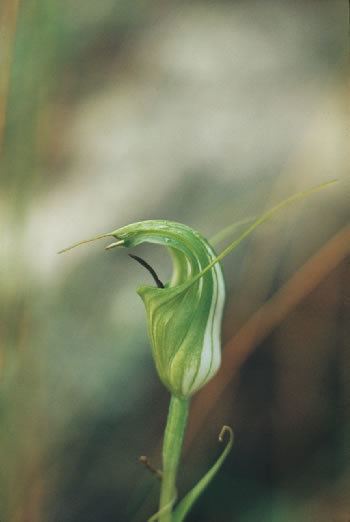Family Orchidaceae Tribe Diurideae Rank Species | Subtribe Pterostylidinae | |
 | ||
Similar Pterostylis plumosa, Pterostylis baptistii, Pterostylis grandiflora, Pterostylis recurva, Pterostylis banksii | ||
Pterostylis metcalfei, commonly known as Metcalfe's greenhood, the large kinked greenhood orchid or Ebor greenhood is a species of orchid which is endemic to the Northern Tablelands of New South Wales. It is known from only three locations and is therefore listed as an endangered species.
Contents
Description
Pterostylis metcalfei has a rosette of 3 to 5 leaves, each leaf 7–30 mm (0.3–1 in) long, 7–20 mm (0.3–0.8 in) wide, dark green and flat.
The flower stem is 10–30 cm (4–10 in)1 long and bears a single flower 23–28 mm (0.9–1 in) long and 9–11 mm (0.35–0.43 in) wide and shiny, greenish-white with darker green stripes. The dorsal sepal is erect at its base but then arches forward, forming a hood over the labellum and has a threadlike tip, 7–14 mm (0.3–0.6 in) long. The labellum is blunt, sharply kinked in the middle and is 13.5–17 mm (0.53–0.67 in) long and about 3 mm (0.1 in) wide. Flowering occurs from March to May.
Taxonomy and naming
Pterostylis metcalfei was first formally described by David L. Jones in 1997 from a specimen collected by Peter Metcalfe on Doughboy Mountain, about 10 km (6 mi) south of Wongwibindi station, on the road to Wollomombi, on 8 May 1994. The description was published in The Orchadian. In 2002, Jones and Clements transferred the species to the genus Diplodium but the move has not been accepted by the National Herbarium of New South Wales. The specific epithet (metcalfei) honours the collector of the type specimen, Peter Metcalfe.
Distribution and habitat
The species is endemic to the New England Tablelands (biogeographic region) at altitudes of 1,000 to 1,350 m (3,000 to 4,000 ft). It is found on ridges and slopes with well drained soil derived from granite and basalt, growing among grass and shrubs. It is known from only three locations, only one of which is in a national park, so that it is threatened by cattle grazing and trampling.
Conservation status
The Scientific Committee of the Office of Environment and Heritage, established by the Threatened Species Conservation Act, has listed P. metcalfei as an Endangered Species on Part 1 of Schedule 1 of the Threatened Species Conservation Act.
